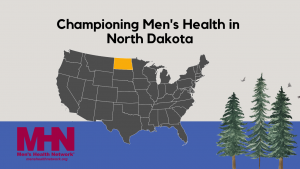Men’s Health in North Dakota
Today in the United States, life expectancy at birth for men is nearly 5.5 years less than life expectancy for women (75.1 years vs. 80.5 years). In North Dakota, the difference in life expectancy between men and women is even wider.
At birth, males in North Dakota are projected to live an average of 77.2 years, while women are projected to live an average of 85.0 years, creating a difference of 7.8 years. This difference is thought to be partly because men prioritize their health less than most women. Nationally, men are more likely than women to engage in unhealthy and unsafe behaviors such as excessive drinking, smoking and driving under the influenceand yet are less likely to visit a health care provider or adopt preventive health measures such as using sunscreen or eating a healthy diet.
Data points like these inspired the creation of the Men’s Health Program at the North Dakota Department of Health and Human Services in October 2021. The program’s mission is to improve the health and well-being of men and boys by increasing access to education and health care and statewide behavioral health services and support.
Areas of focus include; integration of men’s and women’s health programs, promotion of paternity engagementand relationship building with various men’s health stakeholders.
Year 1
The first year of the program was marked by the establishment of connections at the state, local and even national levels. We identified programs and individuals interested in men’s health while assessing the existing network of resources. We partnered with the North Dakota Family Planning Program to create a brochure aimed at men to highlight the extensive list of primary care services offered at the clinics regardless of insurance status. We have partnered with several Title V Maternal and Child Health grantees to encourage the integration of men’s health education and priorities into their existing women’s health education events.
Additionally, we hosted a webinar during Men’s Health Month titled Men’s Mental Health: A Silent Public Health Crisis discuss the social factors contributing to the mental health crisis experienced by men nationally. Since then we have hosted two additional webinars that you can find on our Men’s Health website.
Year 2
In the second year of the program, we have scaled up our efforts to focus more on sustainability and integrate men’s health priorities into a wider range of existing programs. To support these efforts, we have recognized the importance of accessible data which has inspired two very exciting projects: “Data Checklist” and “Surveys of Fatherhood Experiences”.
Data control panel:
Our first project was to create a dashboard with a wide variety of men’s health data. Previously, men’s health data was scattered across numerous datasets and reports, making it difficult to identify specific data points. This dashboard creates a central location for reporting programs to understand trends in behaviors and outcomes for men. This makes it easier for programs to identify disparities and monitor impact.
Father Experience Survey:
We recently launched the North Dakota Fatherhood Experiences Survey for a one-year pilot. The survey is the fifth nationwide instance of a survey designed to capture the father’s perspective on the period before, during and shortly after pregnancy. Research enables examination of the risks, benefits and opportunities associated with parenthood and men’s health to inform future programs and education. The survey is modeled after the Pregnancy Risk Assessment Monitoring System (PRAMS) administered by the CDC since 1987.
Historically, there has been no large-scale, US-based surveillance system that captures the father’s perspective during the transition to parenthood, despite growing evidence of fathers’ impact on family health and their need for support during this transition. of the period. period. We will collect new data to tailor our efforts to best support North Dakota fathers, mothers, children and families to achieve their full health potential.
Best practices:
We are also in the process of creating a live document that will outline some of the best practices when working with men to maximize participation in health promotion initiatives. We detail some of the behavioral barriers men face when it comes to seeking health care. For example, it is seen as a threat to traditional ideals of masculinity to admit that something may be wrong and seek help from a health care or behavioral health provider. Then we adjusted some Do’s and Don’ts by the Interagency Working Group on Gender (IGWG) on working with men and promoting engagement.
We hope this paper will be useful in North Dakota and beyond when planning initiatives that work with men to ensure that programs are aware of important parameters for facilitating engagement.
We’re really excited about these projects and the traction around men’s health that we’ve been able to create in North Dakota.
These projects will not only promote better health in our state, but also contribute to the growing national emphasis on the importance of men’s and boys’ health.

